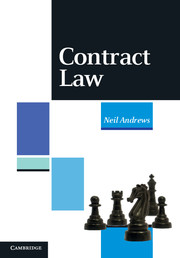Book contents
- Frontmatter
- Contents
- Preface
- Table of cases
- Table of statutes
- Table of statutory instruments
- Part I Introduction
- Part II Formation
- Part III Consideration and intent to create legal relations
- Part IV Third parties and assignment
- Part V Vitiating elements
- Part VI Terms and interpretation
- Part VII Breakdown and liability
- Part VIII Remedies for breach
- 18 Judicial remedies for breach of contract
- 19 Consensual remedies for breach of contract: liquidated damages and deposits
- Part IX Illegality and public policy
- Part X The future
- Appendix: A who's who of contract law
- Bibliography
- Index
18 - Judicial remedies for breach of contract
from Part VIII - Remedies for breach
- Frontmatter
- Contents
- Preface
- Table of cases
- Table of statutes
- Table of statutory instruments
- Part I Introduction
- Part II Formation
- Part III Consideration and intent to create legal relations
- Part IV Third parties and assignment
- Part V Vitiating elements
- Part VI Terms and interpretation
- Part VII Breakdown and liability
- Part VIII Remedies for breach
- 18 Judicial remedies for breach of contract
- 19 Consensual remedies for breach of contract: liquidated damages and deposits
- Part IX Illegality and public policy
- Part X The future
- Appendix: A who's who of contract law
- Bibliography
- Index
Summary
INTRODUCTION
This chapter concerns remedies awarded by the court (on application by an aggrieved party) for breach of contract. The next chapter will concern agreed remedies: payments of liquidated damages for breach, and forfeiture of deposits.
The array of remedies for breach. The five main judicial remedies for breach of contract are as follows:
(1) The action for debt. This is in practice the most common remedy of all. Michael Zander notes that county court debt actions increased during the period 2004–7 to the 2 million level, having been approximately 1.8 million during the years 1999–2003. As for contract doctrine, the main controversy (18.05 ff) arising from debt claims concerns whether a party who has yet to complete performance can legitimately fulfil that task and earn the right to sue the other party for the agreed sum, even though the latter had earlier attempted to call off the job (an unaccepted repudiation, also known as an attempted anticipatory breach).
(2) Damages. This is the common law claim for compensation; most textbooks devote most attention to this technically complex remedy. The main aim of compensatory damages is to place the promisee in the position he would have been in if the contract had been properly performed, the so-called ‘expectation’ or ‘loss of bargain’ measure (18.25). A subsidiary type of damages is to restore the claimant monetarily to the position he enjoyed before the contract was breached, the so-called ‘reliance loss’ measure (18.25, 18.26). Common to both of these measures of damages are the requirements that the loss should be:
[…]
- Type
- Chapter
- Information
- Contract Law , pp. 518 - 597Publisher: Cambridge University PressPrint publication year: 2011

